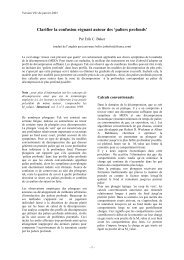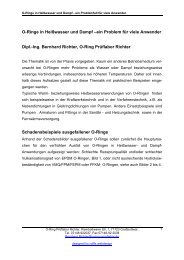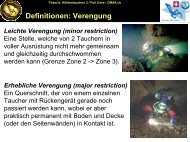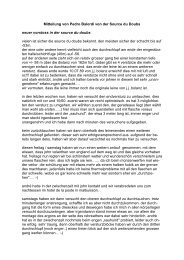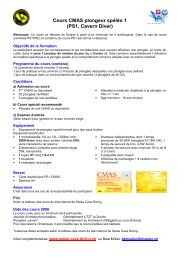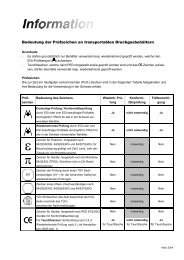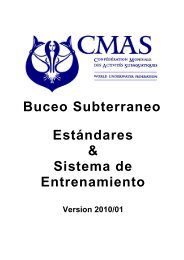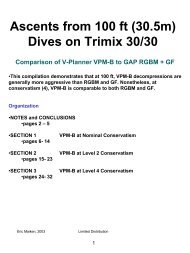cave diving and the nss - bei Swiss-Cave-Diving
cave diving and the nss - bei Swiss-Cave-Diving
cave diving and the nss - bei Swiss-Cave-Diving
You also want an ePaper? Increase the reach of your titles
YUMPU automatically turns print PDFs into web optimized ePapers that Google loves.
HAND SIGNALS 13<br />
Chapter Four<br />
HAND SIGNALS<br />
When one goes <strong>cave</strong> <strong>diving</strong> <strong>the</strong>re is an implicit, or sometimes<br />
even an explicit, agreement that each team member is allowed to<br />
make certain dem<strong>and</strong>s upon <strong>the</strong> o<strong>the</strong>r members. The most important<br />
of <strong>the</strong>se is <strong>the</strong> call for immediate assistance. The "Emergency"<br />
or "Attention" signal is usually performed with <strong>the</strong> light, although<br />
physically grabbing your buddy or anything else necessary to attract<br />
his immediate attention is also acceptable.<br />
O<strong>the</strong>r information may be just as vital, but less urgent, <strong>and</strong><br />
perhaps more complex. To exchange information, <strong>cave</strong> divers<br />
have adapted <strong>and</strong> devised a number of h<strong>and</strong> signs. To be effective,<br />
<strong>the</strong>se h<strong>and</strong> signs must be illuminated <strong>and</strong> care must be taken<br />
to avoid temporarily blinding a buddy while trying to sign to him.<br />
Fur<strong>the</strong>rmore, all members of <strong>the</strong> team must be included in <strong>the</strong><br />
signing. When <strong>the</strong> team consists of only two people, exchanging<br />
information can be as easy as simply facing each o<strong>the</strong>r <strong>and</strong> signaling.<br />
Should <strong>the</strong> team involve three or more people <strong>and</strong> <strong>the</strong>se<br />
people be traveling in single-file formation, <strong>the</strong> information must be<br />
passed from one diver to <strong>the</strong> next. Naturally, this exchange<br />
process is slow, <strong>and</strong> <strong>the</strong> more complex <strong>the</strong> message, <strong>the</strong> greater<br />
<strong>the</strong> likelihood that <strong>the</strong> message will be confused. This is why,<br />
typically, h<strong>and</strong> signs are used to convey only one or two ideas at<br />
a time. Even if <strong>the</strong> message is extremely complex, break it down<br />
into simple portions to be digested by <strong>the</strong> team before offering <strong>the</strong><br />
next morsel.<br />
The basic vocabulary of commonly used signals is fairly<br />
simple <strong>and</strong> straightforward. It consists of what we call "comm<strong>and</strong>"<br />
or "dem<strong>and</strong>" signals, which require a response <strong>and</strong> frequently an<br />
action; "response" signals, which are m<strong>and</strong>atory replies to comm<strong>and</strong><br />
signals, <strong>and</strong> sometimes comm<strong>and</strong> responses of <strong>the</strong>ir own;<br />
<strong>and</strong> "information signals," which can communicate an impressive<br />
amount of both quantitative <strong>and</strong> qualitative information, <strong>and</strong> also<br />
sometimes have <strong>the</strong> force of a comm<strong>and</strong>.<br />
The most common signal, <strong>and</strong> one which qualifies at various<br />
times under all three categories, is <strong>the</strong> "Okay" signal. Vital Alsar<br />
once wrote that during <strong>the</strong> six-month La Balsa ran crossing of <strong>the</strong><br />
Pacific, one of <strong>the</strong> international team members was able to communicate<br />
almost any nuance of expression with <strong>the</strong> two simple<br />
words, "Oh, boy"—joy. sadness, concern, satisfaction, anger, skepticism—even<br />
hunger. Not to be outdone, <strong>cave</strong> divers attempt to<br />
communicate an almost equally impressive array of information <strong>and</strong><br />
emotion with <strong>the</strong> ubiquitous "Okay" sign.<br />
The technical meanings are generally defined as "I'm okay,<br />
are you okay?" "Yes, I'm okay, too," just plain old "Yes" or "All right,<br />
I agree," <strong>and</strong> "I underst<strong>and</strong>." In<br />
actual practice, though, it may<br />
also be used to express anything<br />
from "Wow! This place is really<br />
neat!" to "Are you really sure<br />
you're okay??" to "Oh, yes, by all<br />
means let's go <strong>the</strong>re!" to 'That's<br />
good" to "Yeah, yeah, yeah,<br />
yeah, I've heard it all before, so<br />
tell me something I don't know."<br />
The variance in meaning is differentiated<br />
partiallly by <strong>the</strong> context<br />
<strong>and</strong> partially by <strong>the</strong> manner<br />
of delivery.<br />
When your buddy initiates a<br />
conversation that starts with an




